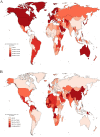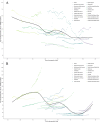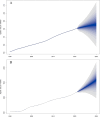Global, regional, and national burdens of type 1 and type 2 diabetes mellitus in adolescents from 1990 to 2021, with forecasts to 2030: a systematic analysis of the global burden of disease study 2021
- PMID: 39876009
- PMCID: PMC11776159
- DOI: 10.1186/s12916-025-03890-w
Global, regional, and national burdens of type 1 and type 2 diabetes mellitus in adolescents from 1990 to 2021, with forecasts to 2030: a systematic analysis of the global burden of disease study 2021
Abstract
Background: Adolescent diabetes is one of the major public health problems worldwide. This study aims to estimate the burden of type 1 diabetes mellitus (T1DM) and type 2 diabetes mellitus (T2DM) in adolescents from 1990 to 2021, and to predict diabetes prevalence through 2030.
Methods: We extracted epidemiologic data from the Global Burden of Disease (GBD) on T1DM and T2DM among adolescents aged 10-24 years in 204 countries and territories worldwide. This study calculated the age-standardized prevalence rate (ASPR) and age-standardized DALY rate (ASDR) in adolescents based on the world standard population for cross-country comparisons. Average annual percentage changes (AAPC) in age-standardized rate were calculated by linkage point regression. Correlation analyses were used to identify the relationship between age-standardized rate and sociodemographic index (SDI). The Bayesian age-period-cohort (BAPC) model was used to predict changes in the diabetes prevalence among adolescents from 2022 to 2030.
Results: In 2021, 3.4 million adolescents were living with T1DM, with an ASPR of 180.96 (95% CI 180.77-181.15), and 14.6 million were living with T2DM, with ASPR of 1190.73 (1190.13-1191.34). As national and territory SDI levels rise, the prevalence rate of T1DM increases (r = 0.44, p < 0.01), and the prevalence rate of T2DM decreases (r = - 0.18, p < 0.01). Compared with males, females had a greater age-standardized prevalence of T1DM (185.49 [185.21-185.76] vs. 176.66 [176.39-176.92]), whereas males had a greater ASPR of T2DM than females did (1241.45 [1240.58-1242.31] vs. 1138.24 [1137.40-1139.09]). This study found a negative correlation between the SDI and the ASDR for both T1DM (r = - 0.51, p < 0.01) and T2DM (r = - 0.62, p < 0.01) in adolescents. For T2DM patients, 32.84% of DALYs were attributed to high BMI, which increased by 40.78% during the study period. By 2030, 3.7 million people are projected to have T1DM, and 14.6 million are projected to have T2DM.
Conclusions: Among adolescents, the burden of T1DM and T2DM is increasing and varies by region, sex, and SDI. Therefore, targeted interventions based on regional features are needed to prevent and control adolescent diabetes. Moreover, more efforts are needed to control climate change and obesity to reduce the adolescent diabetes burden.
Keywords: Adolescent; Diabetes mellitus; Disease burden.
© 2025. The Author(s).
Conflict of interest statement
Declarations. Ethics approval and consent to participate: Ethical approval and informed consent were waived because the GBD is publicly available and no identifiable information was included in the analyses. Consent for publication: Not applicable. Competing interests: The authors declare no competing interests.
Figures






Similar articles
-
Global, regional, and national burden of diabetes and its risk factors in women of child-bearing age, from 1990 to 2021.Public Health. 2025 Apr;241:99-106. doi: 10.1016/j.puhe.2025.02.004. Epub 2025 Feb 18. Public Health. 2025. PMID: 39965323
-
Trends in Prevalent Cases and Disability-Adjusted Life-Years of Depressive Disorders Worldwide: Findings From the Global Burden of Disease Study From 1990 to 2021.Depress Anxiety. 2025 Apr 24;2025:5553491. doi: 10.1155/da/5553491. eCollection 2025. Depress Anxiety. 2025. PMID: 40313474 Free PMC article.
-
Epidemiological characteristics of infertility, 1990-2021, and 15-year forecasts: an analysis based on the global burden of disease study 2021.Reprod Health. 2025 Feb 19;22(1):26. doi: 10.1186/s12978-025-01966-7. Reprod Health. 2025. PMID: 39972325 Free PMC article.
-
Global burden, risk factors, and projections of early-onset dementia: Insights from the Global Burden of Disease Study 2021.Ageing Res Rev. 2025 Feb;104:102644. doi: 10.1016/j.arr.2024.102644. Epub 2024 Dec 17. Ageing Res Rev. 2025. PMID: 39701185 Review.
-
The Rise of Type 2 Diabetes in Children and Adolescents: An Emerging Pandemic.Diabetes Metab Res Rev. 2025 Jan;41(1):e70029. doi: 10.1002/dmrr.70029. Diabetes Metab Res Rev. 2025. PMID: 39744912 Review.
Cited by
-
Temporal changes in the burden of type 2 diabetes mellitus across the BRICS, 1990-2021: a comprehensive analysis for the global burden of disease study 2021.BMC Public Health. 2025 Aug 30;25(1):2982. doi: 10.1186/s12889-025-23786-x. BMC Public Health. 2025. PMID: 40885896 Free PMC article.
-
Barriers and Facilitators to Artificial Intelligence Implementation in Diabetes Management from Healthcare Workers' Perspective: A Scoping Review.Medicina (Kaunas). 2025 Aug 1;61(8):1403. doi: 10.3390/medicina61081403. Medicina (Kaunas). 2025. PMID: 40870448 Free PMC article.
-
Global, regional, and national burden of cataract: A comprehensive analysis and projections from 1990 to 2021.PLoS One. 2025 Jun 23;20(6):e0326263. doi: 10.1371/journal.pone.0326263. eCollection 2025. PLoS One. 2025. PMID: 40549768 Free PMC article.
-
Global burden of mental disorders in 204 countries and territories, 1990-2021: results from the global burden of disease study 2021.BMC Psychiatry. 2025 May 15;25(1):486. doi: 10.1186/s12888-025-06932-y. BMC Psychiatry. 2025. PMID: 40375174 Free PMC article.
-
Global epidemiology of type 1 diabetes in youth: 1990-2021 and projections to 2045.Endocrine. 2025 Jul 19. doi: 10.1007/s12020-025-04356-y. Online ahead of print. Endocrine. 2025. PMID: 40682759
References
-
- GBD 2019 Diabetes and Air Pollution Collaborators. Estimates, trends, and drivers of the global burden of type 2 diabetes attributable to PM2.5 air pollution, 1990–2019: an analysis of data from the global burden of disease study 2019. Lancet Planet Health. 2022;6:e586–600. 10.1016/S2542-5196(22)00122-X. - PMC - PubMed
-
- Global diabetes data report 2000–2045. IDF Diabetes Atlas; 2021. https://diabetesatlas.org/data/. Accessed 20 May 2024.
-
- Dayan CM, Besser REJ, Oram RA, Hagopian W, Vatish M, Bendor-Samuel O, et al. Preventing type 1 diabetes in childhood. Science. 2021;373:506–10. 10.1126/science.abi4742. - PubMed
MeSH terms
Grants and funding
LinkOut - more resources
Full Text Sources
Medical
Research Materials

